1964-1988 El Camino
As one of the industry’s largest A- and G-body restoration suppliers, Original Parts Group offers thousands of 1964-88 El Camino parts and accessories, with new parts added daily. Our extensive catalog offers nearly everything from sheet metal, chrome and upholstery to engine parts and the hard-to-find details to finish a restoration with show-winning attention to detail. Shop online or order your OPG El Camino parts catalog today.
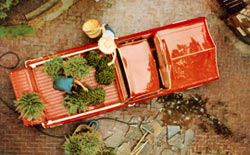 Chevy’s unique El Camino – Spanish for “the road” or “the way” – wasn’t the first vehicle to blend a passenger-car platform with the utility of a truck’s cargo bed, but was the most successful in the United States. It was launched in 1959 on Chevrolet’s full-size platform and lasted two model years, before going on hiatus.
Chevy’s unique El Camino – Spanish for “the road” or “the way” – wasn’t the first vehicle to blend a passenger-car platform with the utility of a truck’s cargo bed, but was the most successful in the United States. It was launched in 1959 on Chevrolet’s full-size platform and lasted two model years, before going on hiatus.
The second-generation El Camino was reborn on GM’s all-new A-body platform in 1964, carrying the styling of the Chevelle in front of its cargo bed. Starting in 1973, the El Camino’s styling followed the evolution of the Chevelle in to the Malibu and its consequent downsizing of the A-body platform, where it remained through the end of production .
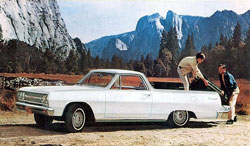
Culturally, the El Camino has been somewhat polarizing to non-enthusiasts, but heavy-duty suspension systems supported the utilitarian purpose of this unique vehicle, gave it respectable cargo-hauling and towing capacity. It also lasted nearly a decade longer on the market than Ford’s Ranchero, proving its distinctive blend of car styling and truck capability was indeed “the way” for thousands of customers.
1964-72: Utility with muscle
Like most trucks at the time, the re-launched, second-generation 1964 El Camino was offered in a base model aimed at budget-conscious fleet buyers and the Custom-series with more trim and amenities. Sales of around 32,500 represented less than 10 percent of the entire Chevelle line’s production in 1964, but it was a strong start that set the tone for the next decade – and tellingly, more than 20,000 of those ’64 El Cams were V-8-powered Custom models.
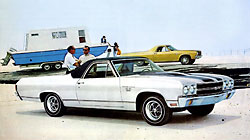 Sales held steady for the next few years, as the truck evolved with the Chevelle’s styling. In 1968, an SS model was officially offered, but from 1969 to ’72, the SS was technically an option package on the uplevel Custom model. Muscle car enthusiasts found the El Camino a less-expensive alternative to the Chevelle – it generally cost less to purchase with the same high-performance engine, including the legendary 1970 LS-6 454 rated at 450 hp. And because it was a truck, it was much cheaper to insure than a Chevelle SS.
Sales held steady for the next few years, as the truck evolved with the Chevelle’s styling. In 1968, an SS model was officially offered, but from 1969 to ’72, the SS was technically an option package on the uplevel Custom model. Muscle car enthusiasts found the El Camino a less-expensive alternative to the Chevelle – it generally cost less to purchase with the same high-performance engine, including the legendary 1970 LS-6 454 rated at 450 hp. And because it was a truck, it was much cheaper to insure than a Chevelle SS.
1973-77: Growing With the Industry
The fourth generation debuted 1973 with the “Colannade” styling of the Chevelle. Dimensionally, it was the largest El Camino in history, with long front and rear overhangs that accommodated new crash standards at the expense of the previous models’ tightly wrapped styling. Just about 65,000 were sold in ’73 – a nearly 15-percent jump over 1972 and the best-ever year for the El Camino.
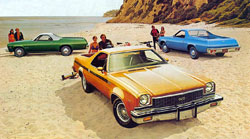 Like every other car on the market in the early-to-mid-Seventies, the revamped El Camino, which shared its chassis with the Chevelle/Malibu wagon, got heavier while losing horsepower and torque. The big-block, however, soldiered on through the end of the 1975 model year, although it put out only a whisper of its output from five years earlier. Nevertheless, the El Camino remained popular and rolled out of its fourth generation in 1977 with more than 54,000 for the year.
Like every other car on the market in the early-to-mid-Seventies, the revamped El Camino, which shared its chassis with the Chevelle/Malibu wagon, got heavier while losing horsepower and torque. The big-block, however, soldiered on through the end of the 1975 model year, although it put out only a whisper of its output from five years earlier. Nevertheless, the El Camino remained popular and rolled out of its fourth generation in 1977 with more than 54,000 for the year.
1978-88: Resized and Refocused
Following Chevrolet’s downsizing of its midsize and full-size lineups, the El Camino shrank in 1978, along with the redesigned Malibu. The fifth-gen El Camino was offered with a wide range of Chevy and even Buick V-6 engines and comparatively anemic small-block V-8s – although their inherent low-rpm torque still made the smaller El Camino a competent hauler and output increased significantly in the mid-Eighties. Chevy even offered the ill-fated 350-cubic-inch diesel V-8 starting in 1983.
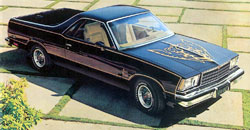 Specialty models included the Super Sport, Black Knight, Royal Knight and Conquista. The Black Knight was a 1978-only offering, because Chevy changed the name to Royal Knight in 1979 after a copywright infringement issue. Also available was the El Camino SS built by conversion-van manufacturer Choo Choo Customs. It used the NASCAR-inspired nose of the Monte Carlo SS for distinction.
Specialty models included the Super Sport, Black Knight, Royal Knight and Conquista. The Black Knight was a 1978-only offering, because Chevy changed the name to Royal Knight in 1979 after a copywright infringement issue. Also available was the El Camino SS built by conversion-van manufacturer Choo Choo Customs. It used the NASCAR-inspired nose of the Monte Carlo SS for distinction.
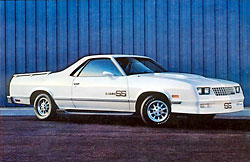 Although 1987 was officially the El Camino’s last year, 420 examples were produced and sold as 1988 models, bringing an inauspicious end to an iconic vehicle. A quarter-century after it went out of production, it remains a polarizing yet popular part of automotive culture – and an enthusiast favorite.
Although 1987 was officially the El Camino’s last year, 420 examples were produced and sold as 1988 models, bringing an inauspicious end to an iconic vehicle. A quarter-century after it went out of production, it remains a polarizing yet popular part of automotive culture – and an enthusiast favorite.